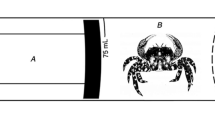Summary
-
1.
In order to determine mechanisms which extend desiccation tolerance in terrestrial anurans, a study of the physiological processes failing in dehydrational death was undertaken withXenopus laevis. At various degrees of dehydration, measurements of resting and active metabolic rates, resting and active heart rates, resting arterio-venous blood oxygen contents (a-v differences), and resting whole animal lactate levels were made to assess cardiovascular-respiratory capabilities.X. laevis was also subjected to various osmotic and ionic loads in order to assess the roles which total osmotic pressure and sodium ion may play in dehydrational death and the animals' ability to consume oxygen.
-
2.
Maximal oxygen consumption rates (\(\dot V_{O_2 }\)max) significantly decreased following evaporative water losses of 20 and 30% of initial body weight when compared to values for hydrated toads. Routine metabolic rates were unaffected by dehydration.
-
3.
Resting heart rates increased with increasing dehydration, while maximal heart rates declined. There was no difference between resting and active rates at a loss of approximately 25% of original body weight.
-
4.
At critical activity point (CAP, the inability to right) there was a significant increase in whole animal lactate, indicating an inability to supply resting metabolic demands aerobically.
-
5.
Following dehydrations to CAP, a-v differences in blood oxygen content increased from values in normally hydrated frogs and venous saturation decreased, indicating a limitation in oxygen delivery.
-
6.
A generalized decline in aerobic metabolic capabilities measured as\(\dot V_{O_2 }\)max could be elicited by salt loadingXenopus. Hematocrit was unchanged in these experiments, thus indicating an intrinsic osmotic effect independent of viscosity effects.
-
7.
The nonpermeant osmotic concentration at CAP chieved either by sucrose or sodium chloride load was around 440 mosM. This was the same nonpermeant osmotic concentration at CAP in normally dehydrated frogs.
-
8.
A critical problem during dehydration inX. laevis appears to be a curtailment of circulatory oxygen delivery capabilities eventually leading to generalized anoxia. The ultimate reason for this debilitation seems tied to a nonpermeant plasma osmotic concentration of around 440 mosM. Increasing viscosity may accentuate this phenomenon but it is not entirely responsible for it.
Similar content being viewed by others
Abbreviations
- CAP :
-
critical activity point (at which animals were unable to right)
- BOC :
-
blood oxygen capacity
References
Bennett, A.F., Licht, P.: Anaerobic metabolism during activity in amphibians. Comp. Biochem. Physiol.48A, 319–327 (1974)
Bentley, P.J., Schmidt-Nielsen, K.: Acute effects of sea water on frogs (Rana pipiens). Comp. Biochem. Physiol.40A, 547–548 (1971)
Charm, S.C., Kurland, G.S.: Blood flow and microcirculation. p. 243. New York: Wiley 1974
Chien, S., Usami, S., Dellenback, R.J., Bryant, C.A.: Comparative hemorheology-hematological implications of species differences in blood viscosity. Biorheol.8, 35–57 (1971)
Cleworth, D.R.: A comparative study on the effects of urea on contraction in skeletal muscle. Ph.D. Dissertation, University of California, Los Angeles (1967)
Farrel, M.P., MacMahon, J.A.: An eco-physiological study of water economy in eight species of tree frogs (Hylidae). Herpetol.25, 279–294 (1969)
Gordon, M.S.: Intracellular osmoregulation in skeletal muscle during salinity adaptation in two species of toads. Biol. Bull.128, 218–229 (1965)
Hillman, S.S.: Cardiovascular correlates of maximal oxygen consumption rates in anuran amphibians. J. comp. Physiol.109, 199–207 (1976)
Hillman, S.S.: Some aspects of the physiology of desiccation and physiological correlates of differential desiccation tolerance in Anuran amphibians. Ph.D. Dissertation, University of California, Los Angeles (1977)
Howarth, J.V.: The behavior of frog muscle in hypertonic solutions. J. Physiol.144, 167–175 (1958)
Ireland, M.P.: Studies on the adaptation ofXenopus laevis to hyperosmotic media. Comp. Biochem. Physiol.46A, 469–476 (1973)
Main, A.R., Bentley, P.J.: Water relations of Australian burrowing frogs and tree frogs. Ecology45, 379–382 (1964)
McClanahan, L.: Adaptations of the spadefoot toad,Scaphiopus couchi, to desert environments. Comp. Biochem. Physiol.20, 73–99 (1967)
Ralin, D.R., Rogers, J.S.: Aspects of tolerance to desiccation inAcris crepitans andPseudacris streckeri. Copeia1972, 519–524 (1972)
Ray, C.: Vital limits and rates of desiccation in salamanders. Ecology39, 75–83 (1958)
Romspert, A.P.: Osmoregulation of the African clawed frog,Xenopus laevis, in hypersaline media. Comp. Biochem. Physiol.54A, 207–210 (1976)
Schlisio, V.W., Jurss, K., Spannhof, L.: Osmo- und Ionenregulation vonXenopus laevis Daud. nach Adaptation in verschiedenen osmotisch wirksamen Lösungen. I. Toleranz und Wasserhaushalt. Zool. Jahrb., Abt. Allg. Zool. Physiol. Tiere77, 275–290 (1973)
Schmid, W.B.: Some aspects of the water economics of 9 species of amphibian. Ecology46, 261–269 (1965)
Seymour, R.S.: Physiological correlates of forced activity and burrowing in the spadefoot toad,Scaphiopus hammondii. Copeia1973, 103–115 (1973)
Shoemaker, V.H.: Physiological effects of water deprivation in a toad,Bufo marinus. Ph.D. Dissertation, University of Michigan (1964)
Thorson, T.B.: The relationship of water economy to terrestrialism in amphibians. Ecology36, 100–116 (1955)
Thorson, T., Svihla, A.: Correlation of the habitats of amphibians with their ability to survive loss of body water. Ecology24, 374–381 (1943)
Tucker, V.: Method of O2 content and dissociation curves on microliter blood samples. J. Appl. Physiol.23, 410–413 (1967)
Vaupel, P.: Effect of percentual water content in tissues and liquids on the diffusion coefficients of O2, CO2, N2 and H2. Pflügers Arch.361, 201–204 (1976)
Author information
Authors and Affiliations
Rights and permissions
About this article
Cite this article
Hillman, S.S. The roles of oxygen delivery and electrolyte levels in the dehydrational death ofXenopus laevis . J Comp Physiol B 128, 169–175 (1978). https://doi.org/10.1007/BF00689481
Accepted:
Issue Date:
DOI: https://doi.org/10.1007/BF00689481




